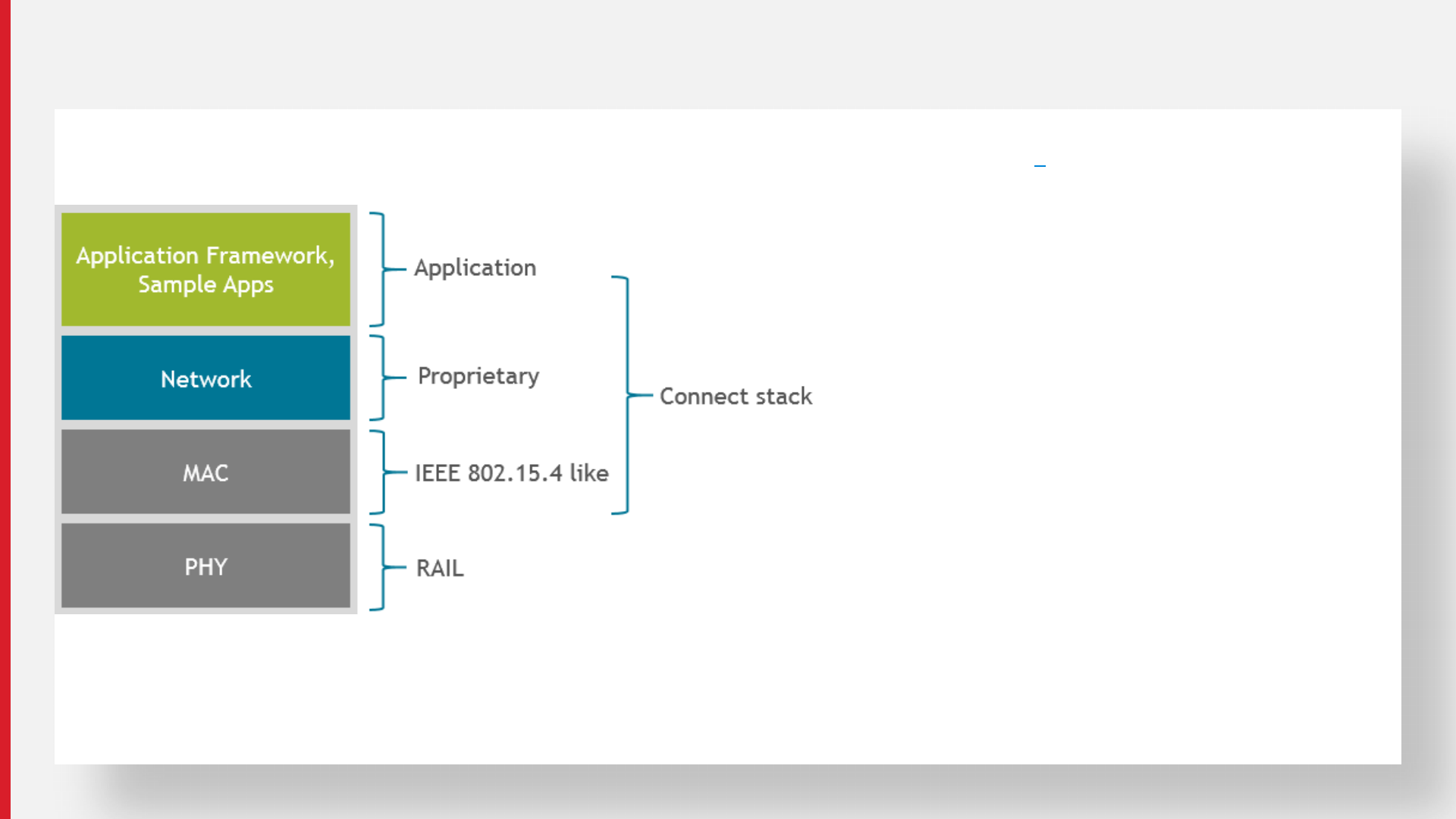
Getting started with Proprietary Wireless
WHAT IS RAIL AND WHAT IS CONNECT

+ Compatibility required with existing proprietary protocol
+ Highly optimized solution needed
+ For energy consumption
+ For wireless range
+ Full control of the protocol is necessary
In exchange:
̶ More difficult development, longer time to the market
̶ Incompatibility with existing infrastructures
̶ Security holes can remain hidden for a long time due to the difficulty of the analysis
§ But once they discovered, it’s usually easy to exploit them
When to use Proprietary?

Silicon Labs IC(s)
Stack (ZigBee, BLE, Connect,
Proprietary)
§ Radio Abstraction Interface Layer
§ Library, used to access radio transceiver hardware
§ Has some MAC features that can be accelerated by HW
§ CRC, whitening
§ Auto ACK
§ Address filtering
§ CSMA/CA or LBT
§ Scheduling and timestamping
§ RAIL should provide a common API across all supported chips
§ All Silicon Labs stacks are implemented on top of RAIL
What is RAIL?
Customer Application
Radio Abstraction Interface
Layer (RAIL)
SW
Portable code
HW

Silicon Labs IC(s)
§ Stack, up to the Network layer
§ Configurable PHY (pre-set PHYs available for all ISM regions)
§ 15.4 based MAC
§ Extended star based network topology
§ Implemented on top of RAIL
§ Special „direct MAC mode”
§ Pure IEEE 802.15.4 MAC implementation
§ Also includes some application layer features
§ Task and sleep scheduler
§ Over-The-Air (OTA) bootloader image distribution
What is Connect?
Customer Application
Radio Abstraction Interface
Layer (RAIL)
SW
Portable code
HW
Stack (ZigBee, BLE, Connect,
Proprietary)

§ Gecko SDK suite is what we usually call “common SDK”
§ All stacks should use common drivers (usually MCU) from a common SDK
§ You can install multiple SDKs under Gecko SDK suite, eg:
§ EmberZNet for Zigbee
§ Bluetooth Smart SDK for BLE
§ Flex SDK for Connect / RAIL
§ It includes common tools for all stacks
§ Gecko Bootloader
§ Non-volatile memory library
§ Flex SDK for proprietary development
§ It includes the Connect stack
§ The RAIL library
§ RAIL and Connect plugins and examples
§ Basically it’s RAIL and Connect sharing the same GUI
§ Connect and RAIL represent two different development workflows in Flex SDK
What is Gecko SDK suite? What is Flex?

Connect or RAIL?
+ Basic PHY and MAC layer functions
+ Very flexible, a lot of services
§ Supports legacy proprietary systems
+ Accelerated MAC is usually enough for single
hop networks
+ Supports Dynamic Multi Protocol (DMP)
+ Can be used with any RTOS
§ But requires careful IRQ setup
‒ No network layer, so no multi-hop support
‒ No application features like OTA
‒ Security must be done in application
+ Full featured stack, including network layer
+ Task and sleep scheduler
+ OTA bootloader
+ MAC provides 15.4 security
+ Supports MicroC OS
‒ Fixed proprietary frame format, can’t connect to
other networks
‒ Not very flexible, e.g. difficult to set up deeper
than EM2 sleep state
‒ Not compatible with DMP (currently)
‒ Only MicroC OS is supported
‒ RTC oscillator is required for scheduler

Connect or RAIL?
+ Basic PHY and MAC layer functions
+ Very flexible, a lot of services
§ Supports legacy proprietary systems
+ Accelerated MAC is usually enough for single
hop networks
+ Supports Dynamic Multi Protocol (DMP)
+ Can be used with any RTOS
§ But requires careful IRQ setup
‒ No network layer, so no multi-hop support
‒ No application features like OTA
‒ Security must be done in application
+ Full featured stack, including network layer
+ Task and sleep scheduler
+ OTA bootloader
+ MAC provides 15.4 security
+ Supports MicroC OS
‒ Fixed proprietary frame format, can’t connect to
other networks
‒ Not very flexible, e.g. difficult to set up deeper
than EM2 sleep state
‒ Not compatible with DMP (currently)
‒ Only MicroC OS is supported
‒ RTC oscillator is required for scheduler

Connect direct MAC or RAIL 802.15.4?
+Deviations from the standards are allowed
+emlib/emdrv
+Full DMP/multiPhy capabilities
‒MAC header must be created manually
‒No standard MAC association
‒Security must be done in application
+Includes MAC security
+Includes association
+Simpler MAC header creation
‒Only a single security mode is supported
‒Only fully 802.15.4 compatible link layer is
allowed
‒No DMP, limited multiPhy
‒emberHAL

Workflow: Connect RAIL
§ “Create an easy to use radio driver, which
hides the complex hardware, and the
differences between generations!”
§ Development flow is similar to EFM32
§ Uses the radio on the register level
§ Very small HAL dependency
§ em_cmu and em_core
§ RadioConfigurator
§ AppBuilder is mostly used as a container
§ Examples are written as an infinite loop in
main.c
§ “Create a free network layer which has
the most used Zigbee features!”
§ Development flow is similar to the
zigbee stack
§ Base (a.k.a. emberHAL) as HAL
§ AppBuilder
§ Heavy use of plugins
§ Application is written as callback
implementations
9 Silicon Labs Confidential

RAIL framework components
§ RAIL framework
§ Part of the Flex SDK
§ Installed in Simplicity Studio with Gecko SDK Suite
§ RAIL 2.x
§ Major API change with DMP in mind.
§ It fixed many API level problems in RAIL
§ It’s expected to be a very stable API
§ Main software components:
§ RAIL API Library
Implements core features and runtime API-s to configure & control the radio
§ Radio Configurator
Calculates all modem parameters – complete radio configuration
§ Sample Applications
Provides code examples for application development
§ Documentation
Includes QSG138 Quick Start Guide, API reference and application notes

§ General
§ Initialize the RAIL API layer.
§ Collect entropy from the radio (if available).
§ Radio Configuration
§ Configure the radio frequency, packet format, channel configuration and other PHY parameters.
§ Query current PHY data rates and parameters like current channel.
§ State Transitions
§ Configure automatic radio state transitions and transition timings.
§ Auto ACK
§ Configure the radio for automatic acknowledgments.
§ Load the auto ack payload.
§ System Timing
§ Get the current time in the RAIL timebase.
§ Configure a timer to trigger an event callback after an absolute or relative delay.
§ Specify where within a packet its timestamp is desired.
RAIL Features 1/4

§ Events
§ Configure which radio or RAIL events the application wants to be told about via callback.
§ Data Management
§ Allows the application to choose the type of data and the method of data interaction through RAIL.
§ Receive
§ Configure receive options like CRC checking.
§ Start or schedule when to receive.
§ Enable and configure Address Filtering for each packet.
§ Transmit
§ Configure the power amplifier (PA) and set transmit power output.
§ Load and send packet data, either immediately, scheduled, or using CSMA or LBT.
§ Control per-transmit options like CRC generation, ACK waiting, etc.
§ Multiprotocol
§ Manage time-sharing of the radio among different protocols.
RAIL Features 2/4

§ Calibration
§ APIs for handling various radio calibrations for optimal performance.
§ RF Sense
§ Enable RF energy sensing of specified duration across the 2.4 GHz and/or Sub-GHz bands (EFR32 only).
§ Packet Trace (PTI)
§ Configure Packet Trace pins and serial protocol.
§ Specify the stack protocol to aid network analyzer packet decoding.
§ Diagnostic
§ Output debug signals like an unmodulated tone and a continuously modulated stream of data.
§ Configure crystal tuning for your radio.
§ Fine-tune the radio tuner frequency.
RAIL Features 3/4

§ Protocol-specific hardware acceleration:
§ IEEE 802.15.4
§ Configure the IEEE802.15.4 2.4GHz PHY.
§ Configure node address and address filtering for IEEE 802.15.4.
§ Configure auto ack for IEEE 802.15.4.
§ BLE
§ Configure the Bluetooth Low Energy 1Mbit PHY.
§ Preamble, sync word and whitening adjustment function for connections.
RAIL Features 4/4
14 Silicon Labs Confidential

§ RAIL: Simple RAIL with HAL
§ RAIL: Simple RAIL without HAL
§ RAIL: Duty Cycle
§ RAIL: Energy Mode
§ RAIL: Range Test
§ RAIL: RAILTEST
§ RAIL: Simple TRX
§ RAIL: Simple TRX with ACK (Software)
§ RAIL: Simple TRX with FIFO (Long Packet)
§ RAIL: WMBus Meter and WMBus Collector
RAIL Software Examples

§ Lab measurement software (CW, PN9, BER, PER, Direct mode, Ctune)
§ Demonstrates the features of RAIL through a command line interface
§ For the full list of commands, type “help” on the CLI, or check the
user guide
§ Consider Current Consumption
§ Uses LCD, pushbuttons and LEDs on the WSTK -> turn off peripherals by
setPeripheralEnable ()
§ Dual Sync support added to configTxOptions and setRxOptions
§ Added the following commands: rxConfig, setRxOptions,
setFixedLength, fifoStatus, dataConfig, setTxFifoThreshold,
setRxFifoThreshold
§ See AN972 for more details
RAIL Software Examples – RAILTEST

§ Connect is a production-quality wireless networking stack and development environment for broad
based proprietary applications
§ Full-featured, easily customizable wireless connectivity solution for the Sub-GHz and 2.4GHz proprietary
market
§ Based on 802.15.4 like MAC
§ Low level details of network formation and radio configuration
§ Customer can focus on application development
§ Provides software portability across platforms and reduces our customers’ time-to-market
§ Optimized for devices that require low power consumption
§ Addresses broad range of applications and supports proprietary wireless protocols across worldwide
geographic regions
§ (EZR32 support was dropped with Flex SDK 2.0)
Silicon Labs Connect Networking Stack

Key Features
§ PHY and MAC
§ based on IEEE 802.15.4 standard
§ Support for 2.4 GHz and sub-GHz PHY
§ Fully tested pre-set PHY
§ Almost complete PHY configuration
§ Encryption and authentication of data packets
§ Key distribution is still the task of the application
§ Nodes are provided with short and long IDs;
Network is identified by its PAN ID (Personal Area
Network)
§ Channel access is regulated via CSMA/CA
§ Frequency hopping provided for regulatory
compliance
§ Network and Application
§ Reliable point-to-point, star, extended star and
direct mode network topologies
§ Network formation: Improved and more secure
15.4-like association mechanism; Centralized
address allocation at the coordinator
§ Full routing support: Any node in the network
can communicate with any other node in the
network; Routing is totally transparent to the
application
§ NCP (Network Co-Processor) mode operation
§ OTA bootloader support
§ MicroC OS support

§ Point-to-point
§ Simplest communication between two devices
§ Star
§ Single Coordinator hub communication with multiple Star End Nodes
§ Extended Star
§ Includes a Star Range Extender between Star Coordinators and Star End Nodes
§ Communication between Coordinator and Far Star End nodes flows through Star Range Extenders
§ Direct mode
§ Two or more Direct nodes everyone communicates with everyone in a single hop fashion
Network Topology
Direct Node
End Node
Range Extender
Coordinator
DirectPoint-to-point
Extended Star
Star

§ Special mode, implementing a 100% IEEE 802.15.4 compatible MAC layer
§ The phy config (e.g. carrier frequency) can deviate from the standard
§ It’s not a full implementation
§ Supports 802.15.4 beacons and association
§ Supports 802.15.4 level-5 MAC security (authentication and encryption)
Direct MAC mode
21 Silicon Labs Confidential

Connect Stack Architecture
§ RAIL (Radio Abstraction Interface Layer) based radio
configuration for EFR32
§ MAC is based on IEEE 802.15.4-2006 standard
§ Network layer is based on a proprietary protocol
§ All network tasks are encapsulated in stack (Libraries)
§ Full routing support that is transparent to the
Application Layer
§ Application Framework can be configured by the user
through a GUI
§ Application code becomes completely portable –
recompile for different regions, different MCUs and
different radios

Thank You!
WWW.SILABS.COM


